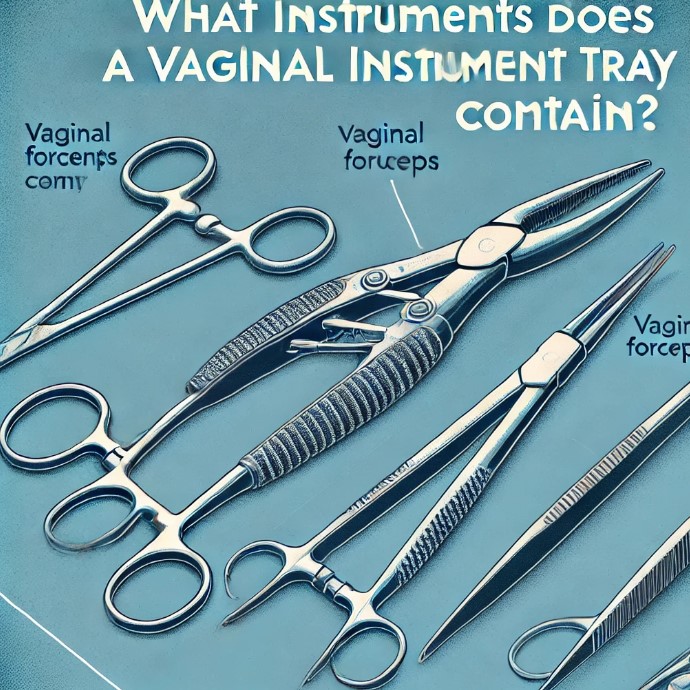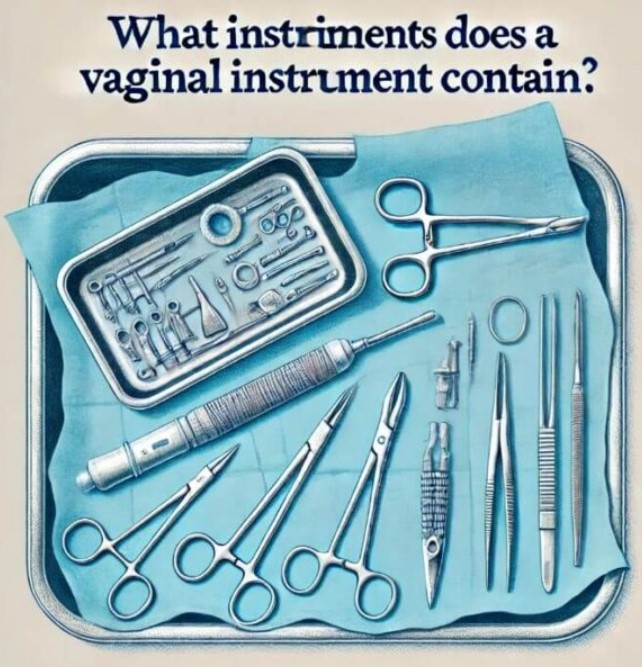There are specific instruments used in gynecological procedures that are crucial to achieving the desired surgical endpoint in a woman’s body. A vaginal instrument tray consists of a standardized set of instruments that are required for vaginal examinations, and from this article, you will learn more about all those tools and their significance in nursing and medicine. Also, get to learn more about different kinds of procedures with a vaginal instrument such as diagnostic, therapeutic, and surgical.
What Instruments Would You Find In A Vaginal Instrument Tray?

All healthcare providers that have had the opportunity to employ vagina instruments know which tools a vaginal instrument should include, hence they carefully prepare a tray for it. Get to see some of the vagina instruments, and their functions in performing a variety of medical services in women.
1. Speculum
Vaginal walls must be expanded in order to gain visibility and access to the cervix, to achieve this right, a speculum is put in place and serves as the main instrument accompanying any examination or other procedure. There are common types of this tool that include Graves Speculum, which consists of blades that are wide apart (Serving the general purpose), and Pederson Speculum which on the other hand caters for anatomy that is small. These speculums are made of either stainless steel or plastic and can either be reusable or for single use.
2. Tenaculum
A tenaculum instrument looks the same as a pair of tongs which are mainly used for holding onto the cervix in place whenever one is administering an Intrauterine Device , does a D&C process or a biopsy. Its rust-proof material is accompanied by sharp pointed tips which prevent damage to the tissue while ensuring a firm grip on the cervix.
3. Uterine Sound
A uterine sound is a long and flexible tool which is used to precisely measure the depth and orientation of the cavity of the uterus. This tool is especially useful when placing an intrauterine device and evaluating uterine abnormalities as well. It is regularly made up of stainless steel and has graduated markings inscribed into the instrument.
4. Dilators
To allow for the insertion of equipment during other procedures the cervical canal is gradually widened through the use of dilators. The set which is commonly used to complete this task are:
• Hegar Dilators: These look like a cylindrical instrument that is hollow in the middle and comes in a variety of lengths.
• Pratt Dilators: These are less contra economic than the other dilators as they allow for a more gradual dilation process.
Cutting and Dissecting Instruments
5. Scissors
The scissors have a pair of blades that are fastened together so that the blades can pivot to cut tissue and stuff in gynecology scissors which are for instance:
• Mayo Scissors: These are made for going through thicker tissues.
• Metzenbaum Scissors: These are constructed with a sharper blade to go through delicate tissues.
• Bandage Scissors: Used for gauze or dressings.
6. Curettes
Curettes are used for the scraping and the removal of the tissues that are not required such as from the lining of the vagina or the uterine parts.
• Sharp Curettes: For complete tissue removal.
• Suction Curettes: Mostly in aspiration and other procedures where less invasiveness is required.
Automatic Holding Grasping Instruments
7. Allis Clamp
The Allis Clamp’s design and uses allow this instrument to grasps and gently hold soft tissues while minimizing tissue damage during operations. It does make it easier for the physician as it provides a strong grasp.
8. Foerster Sponge Forceps
These forceps are used to grasp sponges or gauzes for the cleansing of vagina or application of snips.
9. Ring Forceps
Tissues or objects within the vaginal canal can be grasped and held with ring forceps to give the healthcare worker better control.
Auxiliary and Diagnostic Instruments
10. Biopsy Punch
This is a classic blood sampling instrument used when small pieces of tissue from the vaginal wall and cervix are eliminated for pathological diagnostics.
11. Endocervical Curette
This type of curette is particularly used for the collection of tissues from the endocervical canal for the diagnosis of some cervical disorders.
12. Needle Holder
A needle holder is a cutting tool that is scissor shaped and helps in holding needles always during lacing to make the procedure of buli and fixing blood vessels shallow and effortless.
13. Vaginal Packing Forceps
These forceps pack into or remove vaginal packing materials. They are commonly used during or after operations.
Hygiene and Sterility Accessories
14. Bowls and Basins
Sterile bowls and basins are of utmost importance to keep the working area clean and sterile. These bowls and basins are used to store antiseptic solutions, saline, or sterile water for any procedure.
15. Instrument Tray
All tools are organized in an instrument tray that is also designed to keep them sterile. It is quite helpful during the procedure since the practitioner can access all the tools without any hassle.
16. Disposable Accessories
Items that are meant to be disposed of are included in vaginal instrument trays in order to retain sterility and hygienic measures for the patient’s comfort, some of these include:
• Sterile gloves
• Cotton balls
• Swabs
• Lubricant jelly
Common Instruments in a Vaginal Instrument Tray
| Instrument | Purpose | Material |
|---|---|---|
| Speculum | Visualization of cervix | Stainless Steel/Plastic |
| Tenaculum | Stabilization of the cervix | Stainless Steel |
| Uterine Sound | Measurement of uterine depth | Stainless Steel |
| Dilators | Cervical dilation | Stainless Steel |
| Scissors | Cutting tissue or materials | Stainless Steel |
| Curettes | Tissue scraping | Stainless Steel |
| Biopsy Punch | Collecting tissue samples | Stainless Steel |
FAQs
What is the purpose of a speculum?
During gynecological procedures, a speculum is used to broaden the vaginal canal allowing direct view and reach of the cervix.
Are all instruments reusable?
No all instruments would fall into the reused category; while certain metal tools like sterilized scissors and clamps are reusable plastic speculums and several other items are not.
What are dilators used for?
Dilators are intended to gently enlarge the cervical canal in procedures like hysteroscopy or the more common dilation and curettage (D&C), in which the uterus is hollowed out.
Is a biopsy punch always autoincluded inside a vaginal instrument tray?
They are included in case of tissue sampling like a biopsy of the cervix.
Why is the uterine sound so significant?
Uterine sound aids in device placement by measuring the device depth and axis to the uterus, ensuring proper placement of devices like IUDs.
Are the tray contents consistent with the same procedure?
Yes, they are not the same, since the tray includes the required instruments via different procedures, may it be diagnostic, therapeutic, or surgical.
Conclusion
The vaginal instrument tray is pertinent in gynecological care because it guarantees the patients’ comfort and hygiene with an array of specialized devices that allow optimal use of precision. The trifecta of success will be ensured by the use of transecting instruments such as the speculum and the biopsy punch to name a few. This knowledge is essential since it enhances the efficiency and quality of such care, to the benefit of practitioners and their patients.
Visit Thinkow for more topics!


